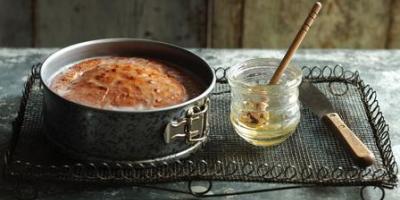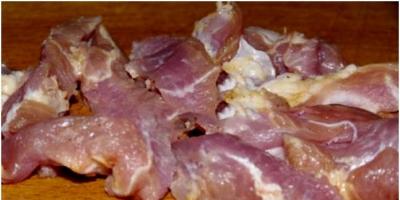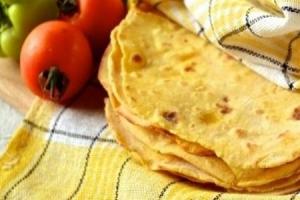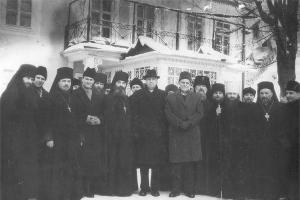According to an ancient legend, once upon a time, God forbade all living beings to work on Saturdays. But the bees and the meadow clover disobeyed him. For this, an angry God punished the plant and hid its nectar in the very depths of the flower. Since then, bees can no longer reach it and only bumblebees pollinate clover flowers. Let's talk about this “naughty” plant today, learn more about meadow clover, application, description, treatment.
Description of red clover
Every summer our meadows are covered with delicate pink, reddish-lilac fluffy flowers. This is the flowering and fragrant meadow clover - perennial, herbaceous plant, belonging to the legume family. This plant is 20-50 cm high, has a taproot, branched root, flowering stems with trifoliate leaves that close after sunset.
The leaves of the plant are ovate, with small teeth and oblong upper leaves. Blooms from May to September. Fluffy flowers, irregular shape. The fruit is a bean.
Flowers and inflorescences of the plant along with the apical leaves are used in medicine. They are collected during the flowering period, dried in the fresh air, in the shade, or using a dryer heated to 60 degrees. When drying, you should not allow the clover to dry out, as this will cause it to lose its healing qualities. Shelf life in tightly closed containers is up to 1 year.
Description of biological composition
The use of red clover in the treatment of diseases
Due to their composition, the leaves and flowers of meadow clover are used as an emollient, analgesic, antitumor, wound-healing, anti-inflammatory, and diaphoretic. Infusions and decoctions of the plant have choleretic, diuretic, expectorant, antitumor, astringent, antiseptic, desensitizing, hemostatic effects.
Preparations based on it are used to treat anemia, inflammation of the bladder, to alleviate painful menstruation, heavy uterine bleeding. Clover is used to get rid of bronchitis, bronchial asthma, and shortness of breath.
Described bio chemical composition helps remove bad cholesterol, so clover is useful for older people to prevent the development of atherosclerosis.
Fresh leaves, crushed to a pulp, are used to treat difficult-to-heal wounds, stop bleeding, to heal skin damaged by burns, abscesses, and rheumatic pain.
They successfully treat suppuration of the nail, finger, skin tuberculosis, inflammatory diseases of the ears and eyes with fresh crushed leaves (externally). Freshly squeezed plant juice is also used for these purposes.
By using alcohol tincture meadow clover flowers successfully treat tuberculosis. It is often included in chest and stomach preparations. Infusion and decoction of clover are used for medicinal baths for rickets in children. A decoction of the roots of the plant is used to treat inflammatory diseases of the ovaries, and also as an antitumor agent.
Treatment with meadow clover according to folk recipes
Decoction from the roots of the plant
Grind 20 g of clean, dried roots, pour 1 tbsp. boiling water, place the dishes with the roots in a water bath over low heat, simmer for half an hour. Strain, squeeze out the raw materials, add boiled water to the original volume. Drink 1 tbsp. l. up to 6 times a day, before meals.
Infusion of leaves, flowers, inflorescences of clover
A medicinal infusion is also used for treatment. To prepare it, pour 2 tbsp. l. crushed dry raw materials 1 tbsp. boiling water, cover with a lid, wrap, leave for half an hour.
Strain, take 2 tbsp. l. before eating. This remedy is used to treat anemia, headaches, to prevent atherosclerosis, and also to eliminate vitamin deficiency.
Tea made from clover flowers and inflorescences
1-2 tbsp. l. Brew dried flowers in a teapot. Leave covered with a towel for 10 minutes, drink as tea throughout the day to cleanse and improve blood composition. You can drink 3-4 cups of tea throughout the day.
Few people know, but fresh pink flowers can be used to make delicious, medicinal oil for sandwiches. Here is a description of its preparation: Mix 100 g of fresh butter and 100 g of finely grated hard cheese.
Add 10 fresh clover flowers, ground to a paste, 1 tsp. crushed dill seeds. Salt, pepper, spread on a piece of black bread or dry biscuits. This sandwich will serve as an excellent addition to morning tea.
You can prepare light spring cabbage soup with the addition of clover flowers. To do this, add finely chopped potatoes to boiling water. After 10 minutes, put the leaves of sorrel, clover, golden fried onions into the pan, crack a couple of raw eggs directly into the cabbage soup, mix well. Pour cabbage soup into plates and season with sour cream.
Go to the meadow in the summer, collect healing meadow clover, dry it in the shade, and use it in treatment. Just be sure to consult your doctor before doing this. Be healthy!
Cultivation of clover began in the 15th century in Italy, then the crop appeared on the border of Holland, and later in Germany. And in the 1630s it began to be cultivated in England. In Russia, clover appeared in the 18th century and was treated with some caution.
Soon, the herb began to be used to diversify the feed diet of livestock, and also found its niche in the “bag” of herbalists, and after some time it began to be considered medicinal. Today, clover is grown as green manure, ornamental plant and for livestock feed.
Red clover, plant description
The grass is clover perennial reaching a height of 15-25 cm. The root system is well developed, the root is taprooted, branched, and has nodule growths. The axils of the basal leaves of clover produce stems crowned with shaggy spherical buds.
The plant's foliage folds when darkness comes, thus retaining twice as much moisture. The leaves have a trifoliate-complex shape, located on short petioles that lengthen along the height of the stem.
Clover begins to bloom in May and June. The flowers are round, often of different shapes, pink, red, white and speckled in color, do not exceed 1.5 cm in size, and are arranged in the form of capitate inflorescences. The fruits of clover can be called egg-shaped beans with very small brown seeds. The clover flower is often popular in decorative lawns.
The place where meadow clover grows is still Europe, Russia, and Asia.
Medicinal properties of clover and chemical composition
Clover is the concentration of many healing, tannins, esters, glycosides, trifolin, organic acids (such as coumaric, salicylic and ketoglutaric), and also absorbs resins and vitamins, isoflavones, thiamine and sitosterol.
 During flowering, the ground part of clover contains more than 25% protein, 2% vegetable fats, 0.02% carotene, about 0.13% ascorbic acid, more than 1.4% free amino acids, as well as calcium and phosphorus.
During flowering, the ground part of clover contains more than 25% protein, 2% vegetable fats, 0.02% carotene, about 0.13% ascorbic acid, more than 1.4% free amino acids, as well as calcium and phosphorus.
Clover flowers contain in a large proportion: flavonols (pratoletin, kaempferol and quercetin), isoflavones (genistein and formononetin), and the content of esters exceeds 0.05%, of which a large proportion is coumarin.
The foliage contains maakiain, which has an antifungal effect. During the growing season, clover roots accumulate about 125 kg. nitrogen per hectare. Clover seeds contain about 15% fatty oils.
Preparations based on clover are presented in the form of dietary supplements, mixtures and teas. Indications for use of these are: anemia, inflammation of various etiologies, painful menstruation, inflammation of the urinary tract, uterine bleeding, diseases of the upper respiratory tract, and also as a preventive agent for atherosclerosis and inflammatory processes in women.
 Externally, clover infusions are used to disinfect and quickly heal abrasions, relieve swelling after bruises and for rheumatic aching pain. Herbalists advise using red clover juice to get rid of foot fungus, inflammatory diseases of the nasopharynx, ear and abscesses.
Externally, clover infusions are used to disinfect and quickly heal abrasions, relieve swelling after bruises and for rheumatic aching pain. Herbalists advise using red clover juice to get rid of foot fungus, inflammatory diseases of the nasopharynx, ear and abscesses.
Modern pharmacology obtains biologically active vitamin supplements from clover leaves. Clover is included in various healing herbal compositions and teas.
The juice squeezed from the leaves of meadow clover is used for inflammation of the eyes; herbalists used dried clover flowers as a diuretic, to increase appetite, and to treat tuberculosis, whooping cough and herpes.
Clover variety
Clover makes up a fairly large group of varieties that differ in shape, purpose, size, flowering time and botanical characteristics; the most prominent representatives include:
 meadow clover one of the representatives of legumes, grows as a perennial spreading bush up to 35 cm high. The leaves are triple, wide, with triangular stipules. Flowering begins in the southern regions in May, in the northern in June. The flowers are small, moth-type, spherical, bright pink.
meadow clover one of the representatives of legumes, grows as a perennial spreading bush up to 35 cm high. The leaves are triple, wide, with triangular stipules. Flowering begins in the southern regions in May, in the northern in June. The flowers are small, moth-type, spherical, bright pink.
Habitats: meadows, fields, edges, forests.
White clover or creeping clover, bushy herbal plant, with creeping shoots, trifoliate leaves, oval-ovate in shape. Flowering begins in May-June, the lifespan of the peduncle is about one and a half weeks. The flowers are spherical, about 1.5 cm in size, of the moth type. The height of the plant reaches 15 cm.
Creeping clover is used to decorate lawns.
The plant is unpretentious. It grows quickly and does not require painstaking care.
Pink hybrid clover, a herbaceous shrub with trifoliate leaves and spherical inflorescences. The species received its name due to the shade of the cap of the inflorescences. The foliage has a “classical” complex shape, trifoliate on short petioles. The plant grows up to 45 cm, is unpretentious and resistant to drought. It grows wild in meadows and along the banks of water bodies.
 Alpine clover, has a powerful root, stays deep in the ground. It grows up to 40 cm, has fairly large stipules and impressive leaves for clover, located on short petioles.
Alpine clover, has a powerful root, stays deep in the ground. It grows up to 40 cm, has fairly large stipules and impressive leaves for clover, located on short petioles.
The grass is grown for silage, and as a crop - green manure. The stable plant does not require additional care and grows well in any soil.
Arable clover, popularly called “cat”. This annual plant, represented by a spreading lush shrub, with a straight stem and trifoliate, carved foliage.
It blooms in May, the inflorescences are represented by pale, pink, spherical heads. The height of the stem does not exceed 25 cm, the plant perfectly adapts to weather conditions and tolerates drought well.
cup clover, a species that includes several subspecies of different shapes and sizes. It is found frequently, grows up to 45 cm, and is unpretentious. It has large carved oval-shaped leaves, collected in threes on one short petiole. The inflorescences are large, about 5 cm. The colors of the flowers vary, from milky to purple.
The fruits of the cup type are small capsules with seeds inside.
 Clover multileaf, a perennial herb with a developed root system represented by a tap root. Unpretentious, stable and tenacious. Issues a large number of peduncles, blooms from May to June. The foliage is located on short petioles. The inflorescences are umbrella-shaped, fluffy, from pink to dark purple. Grows up to 35 cm.
Clover multileaf, a perennial herb with a developed root system represented by a tap root. Unpretentious, stable and tenacious. Issues a large number of peduncles, blooms from May to June. The foliage is located on short petioles. The inflorescences are umbrella-shaped, fluffy, from pink to dark purple. Grows up to 35 cm.
Growing clover
After several years of active cultivation of tuber crops in the same area, its depletion occurs, and in order to replenish the reserves of nutrients, one should resort to sowing green manure crops, such as clover.
Clover is also excellent as mulch; after mowing and chopping, it is enough to simply scatter the chopped green mass over the area and the soil is no longer in danger of cracking; it remains moist and loose for a long time.
Before sowing clover, you need to prepare the seeds and cultivate the soil; plowing and harrowing are quite enough. Clover is a herbaceous plant that does not require care; it grows well on any soil, except saline and “acidic” soils. It grows quickly and easily withstands bad weather.
 It is sown mainly on cultivated areas for pastures and as a green manure crop. In this case, business owners give preference to three types of clover: meadow, creeping white or pink.
It is sown mainly on cultivated areas for pastures and as a green manure crop. In this case, business owners give preference to three types of clover: meadow, creeping white or pink.
Agricultural technology for growing clover is no different from sowing technology perennial herbs, sowing is carried out in field and forage crop rotation. The most suitable predecessors are cereals and root vegetables.
Sowing dates vary depending on the sowing zone; in the southern regions, sowing can begin in March, with norms of about 13 kg. per hectare of area, this is approximately 8.5 million seeds; at this rate, field germination is more than 58%.
With early sowing, the first clover shoots will appear within a week, and the pores will begin to develop quickly. In the first phase of growth, the root system actively develops, it will have a beneficial effect on the composition of the soil, while completely suppressing the appearance of weeds. With sufficient moisture, up to 450 centners can be obtained from clover crops during a productive year. greenery per hectare.
 As for care, clover practically does not need it, but if the grass is grown for food, it should be juicy and there should be a lot of it, so it is necessary to apply mineral fertilizers and nitrogen during the growing season of the plant.
As for care, clover practically does not need it, but if the grass is grown for food, it should be juicy and there should be a lot of it, so it is necessary to apply mineral fertilizers and nitrogen during the growing season of the plant.
Autumn sowing of clover can be laid under the cover of winter crops of barley or other cereals at the time of sowing winter crops.
The norm for sowing under cover is considered to be 125 kg. per hectare of arable land, planting depth is from 5 to 6.5 cm. Afterwards, cereal grasses of about 22 kg are sown separately on the same area, 2.5 cm deep. per hectare of sown area.
Clover does not require special care; the entire vegetative process requires only watering. The powerful root system kills any weeds, but requires moisture. Watering in dry regions should be done at least once a week.
In the second year of crop life, for more juicy and lush greenery, it would not be amiss to apply nitrogen and phosphorus fertilizers. Phosphorus is applied in the spring, and nitrogen fertilizing is carried out in two stages, mainly after the third mowing, in equal parts.
Application of clover
 The value of clover is due to its unpretentiousness and large volumes of green mass at the output. The grass is used as fodder for rabbits, poultry and livestock (in dried form). Clover is not only a high-protein plant, but more often than not, it is also decorative.
The value of clover is due to its unpretentiousness and large volumes of green mass at the output. The grass is used as fodder for rabbits, poultry and livestock (in dried form). Clover is not only a high-protein plant, but more often than not, it is also decorative.
Today you can see lawns of clover and decorative designs from forbs. Therefore, low-growing and creeping types of clover are of particular importance to landscape designers. Clover is used not only as a monoculture in the design of lawns, but also as an addition to the main cover lawn grass. To get a more "fun" look.
In addition to lawns, white clover You can use low-growing trees to decorate the trunk space, which looks unusual and pleases the eye.
Using clover for table purposes is also appropriate. Its dry mass was previously used in baking rye bread. Clover greens are added to first and second courses.
Asian cuisine uses flowers and young shoots of clover for pickling and adding to salads.
 In terms of nutritional characteristics, clover is not inferior to alfalfa and is considered one of the highly valuable forage grasses. It is harvested for hay and silage, and given to livestock dried and fresh. As green manure, clover enriches the soil with nitrogen and increases the fertility of areas; when plowed, it saturates the soil with humus.
In terms of nutritional characteristics, clover is not inferior to alfalfa and is considered one of the highly valuable forage grasses. It is harvested for hay and silage, and given to livestock dried and fresh. As green manure, clover enriches the soil with nitrogen and increases the fertility of areas; when plowed, it saturates the soil with humus.
The fungicidal substance trifolyrizin is isolated from clover roots.
Esters are used in the manufacture of perfume compositions. The grass is also a valuable honey plant, but only for bees of a certain group that have a long proboscis.
Honey obtained from different varieties Clover is considered medicinal, retains a liquid consistency for a long time, has an unsurpassed, rich aroma and excellent sugary taste.
 Collection and storage of clover
Collection and storage of clover
Clover is cut for hay during the period of budding and flowering, in dry sunny weather. Later cuttings will lead to shedding of the lower leaves, loss of part of the plant’s mass and a decrease in its nutritional value.
The optimal height of a plant for cutting is considered to be 9-10 cm. After cutting clover for hay, you should carefully ensure that the grass does not dry out, the mown mass is raked into windrows, and after drying, it is collected into shocks and stacked.
Clover seed material is collected in the second year, from the second mowing; harvesting is carried out with special combines when the seed box turns brown. The average yield of clover seeds is about 2.5 centners per hectare. After threshing, the seeds are subject to sifting, drying and sorting.
 The medicinal parts of clover are the inflorescences and the upper crown part. Collection is carried out manually, in the flowering phase.
The medicinal parts of clover are the inflorescences and the upper crown part. Collection is carried out manually, in the flowering phase.
After harvesting, clover is dried and stored in fabric bags, and then brewed as needed.
The clover plant belongs to the legume family. Clover can reach up to 50 cm in height.
Clover can be either an annual or perennial plant. The flowers are white or red and are collected in the form of heads. The leaves are trifoliate, less commonly found with 4 petals. Very often you can hear about a symbol of good luck - if you find a clover with 4 leaves. The roots can sometimes become woody.
Genus: Clover
Family: Legumes
Class: Dicotyledons
Order: Legumes
Department: Flowers
Kingdom: Plants
Domain: Eukaryotes

A distinctive feature of clover is that it is pollinated only by bees and bumblebees. After the flowers have faded, the fruit remains - a bean, which contains 1 or 2 seeds. Clover is a forage plant, but there are also several types of decorative clover.
Clover roots contain special bacteria that help saturate the soil with nitrogen. The most common varieties of clover are red clover (meadow) and white clover (creeping), which differ in appearance by the color of their flowers. There are also more rare species clover.
Where does clover grow?
The clover plant can be found on all continents of our planet, except Antarctica. Feels good in temperate zones of continents, northern Africa and even Australia. Most often you can find it in clearings, forest edges and meadows. It grows well in cities too. Few people have not been familiar with this plant since childhood.
Medicinal properties of clover
Clover has anti-inflammatory, anti-inflammatory, antiseptic, choleretic, diaphoretic, diuretic, hemostatic, expectorant, astringent properties and is used in the treatment of many diseases.
Clover is either consumed internally in the form of decoctions or made into lotions. This plant helps relieve inflammatory processes in the body, cleanse the blood, relieve swelling and remove excess fluid from the body. helps with colds, headaches, and atherosclerosis. And lotions can be used for wounds, burns, and skin diseases.
Clover honey is also very useful. At the same time, it tastes very pleasant and smells aromatic.
If you liked it this material, share it with your friends on in social networks. Thank you!
Red clover - Trifolium pratense L. " style="border-style:solid;border-width:6px;border-color:#ffcc66;" width="250" height="334">
style="border-style:solid;border-width:6px;border-color:#ffcc66;" width="300" height="225">
style="border-style:solid;border-width:6px;border-color:#ffcc66;" width="250" height="333">
Other names: Balash, White porridge, God's bread, Volashok, Elm, Gogolechka, Golovok, Gorshatnik, Woodpecker, Woodpecker, Woodpecker, Woodpecker, Woodpecker, Woodpecker, Stallion, Hare's feet, Scrofula grass, Ivasik, Ivilnik, Izmetnik, Ilyushnik, Kalachiki, Crucian carp, Red clover, Kovrizhki, Rug, Goat's eye, Komanitsa, Konevicnik, Konevnik, Konychina, Konyushina, Konyushka, Seals, Krasnogolovka, Kuklas, Lapushka, Lapushnik, Fever grass, Fever grass, Horseman, Horsewoman, Makushnik, Malitsa, Manushnik, Honey cake, Honey cake , Honeydew, Lungwort, Meadowgrass, Nukisha, Nuts, Butts, Bee bread, Bee lover, Bee picker, Smoktushki, Sucker, Sukhovershnik, Treushnik, Trefoil, Troezele, Trinity, Troyan, Bread, Khreshchatka, Apples, Yasholnik.
Diseases and effects: anemia, lung diseases, upper respiratory tract diseases, bronchial asthma, shortness of breath, malaria, scrofula, painful menstruation, inflammation of the bladder, allergic skin diseases, vasculitis, baldness, graying of hair, vitiligo, urolithiasis, scrofula, bleeding, wounds, burns, abscesses, felon, conjunctivitis, rheumatism, suppuration of the nail bed and fingers, skin tuberculosis, inflammatory diseases of the ears and eyes, rickets, boils, eczema, frostbite, bedsores, ulcers, vitamin deficiency, uterine bleeding, anemia, exhaustion, tumors, diabetes, inflammation of the ovaries.
Active substances: trifoline, isotrifolin, isorhamnetin, quercetin, asparagine, tyrosine, ascorbic acid, salicylic acid, coumaric acid, sitosterols, vitamin E, vitamin K, B vitamins, carotene, alkaloids, essential oil, resins, bioflavonoids, pigments, trifolesin.
Time to collect and prepare the plant: May - September.
Botanical description of red clover
Clover- a perennial, less often biennial, herbaceous plant of the family Legumes (Mothaceae) — Fabaceae (Leguminosae).
Root core, branched, well developed. Reaching a depth of up to 2 m, it has small nodules in which bacteria live, extracting nitrogen from the air.
Main stem short, reduced. flowering stems ascending, grow from the axils of the basal leaves, reaching a height of 15-60 cm.
Leaves Trifoliate, petiolate, with broadly ovate leaves. The lower leaves are finely toothed along the edge, and the upper ones are entire, elongated-ovate. At night the leaves are folded. Individual leaves most often have an arrow-shaped white pattern.
Flowers small, red or pink, zygomorphic, collected in inflorescences - loose round or slightly oblong single, and more often paired heads with a wrapper of two upper leaves. The size of the flowers is 1-2 cm in length. Meadow clover blooms from spring until frost.
Fetus- ovoid single-seeded bean.
Distribution and habitat of red clover
Clover in Ukraine and the European part of Russia is found everywhere in meadows, pastures, pastures, gently sloping banks of reservoirs, along roads, and often forms a continuous meadow cover.
Harvesting red clover
For medicinal purposes, inflorescences with upper leaves are prepared. They do this throughout the summer.
Inflorescences with apical leaves are plucked by hand or cut off with a knife; the whole inflorescence with wrapper, without peduncles, is loosely placed in baskets and quickly dried in the shade, under a canopy or in a dryer at a temperature of 60-70 ° C, making sure that the raw materials do not dry out, since when this way it loses its value. Store inflorescences in a dry, shaded place in a closed container for 2 years, and herbs for 1 year.
Sometimes roots are prepared as medicinal raw materials and dried in the usual way.
Chemical composition of red clover
The grass and inflorescences of meadow clover contain glycosides trifolin and isotrifolin, isorhamnetin, quercetin, asparagine, tyrosine, ascorbic, salicylic and coumaric acids, sitosterols, vitamins (E, K, group B), carotene, alkaloids, essential oil, resins, bioflavonoids.
Red clover leaves contain ascorbic acid and pigments. The antifungal substance trifolesin was isolated from the roots.
Pharmacological properties of red clover
Red clover has an expectorant, diuretic, diaphoretic, hemostatic and antiseptic effect.
The use of red clover in medicine
Currently, clover is used only in folk medicine.
Infusion and decoction of fresh or dried clover inflorescences are used for anemia, lung diseases, diseases of the upper respiratory tract, bronchial asthma, shortness of breath, malaria, scrofulosis, painful menstruation, inflammation of the bladder. They are also taken for allergic skin diseases, vasculitis, baldness, graying of hair, vitiligo, urolithiasis, scrofula.
Flavonoids contained in clover prevent the accumulation of cholesterol in the blood, so the plant is used to prevent atherosclerosis.
Fresh crushed leaves and heads, as well as fresh plant juice, are used externally to stop bleeding, heal wounds, for burns, abscesses, panaritiums, in the treatment of conjunctivitis, and also for rheumatic pain.
Fresh juice of the plant is effective against suppuration of the nail bed and fingers, skin tuberculosis, inflammatory diseases of the ears and eyes.
Externally, clover is used for baths for rickets in children, allergic skin lesions, as well as in the form of lotions and poultices for boils and eczema. It is used externally and for frostbite, bedsores and ulcers.
An aqueous infusion of clover is used for vitamin deficiencies.
Clover blossom tea - recognized folk remedy with uterine bleeding.
Clover is also used for anemia, exhaustion, tumors, and diabetes.
A decoction of meadow clover roots is indicated for inflammation of the ovaries and as an antitumor agent.
In Central Asia, the juice of fresh grass has long been used to heal wounds, and a decoction of dry grass has been used for malaria as a diuretic.
Dosage forms and method of use of red clover
Decoction of clover inflorescences. Brew 250 ml of boiling water and 20 g of inflorescences, cook for 15 minutes, leave for 30 minutes, strain. Drink 50 ml 3-4 times a day for urolithiasis, chronic cough, bronchial asthma, anemia, scrofula. Use externally as a lotion for burns, frostbite, bedsores, abscesses, to wash festering wounds and ulcers.
Clover herb infusion. Brew 200 ml of boiling water and 40 g of herbs, leave for 1 hour, strain. Drink 50 ml 3-4 times a day for coughs and colds.
Clover inflorescence infusion. Brew 200 ml of boiling water for 30 g of flower heads, leave for 1 hour in a warm place in a sealed container, then strain. Take 50 ml 4 times a day 30 minutes before meals for chronic cough, gastritis, skin diseases, colitis, cholecystitis, diathesis. Wash wounds, ulcers, apply lotions to inflamed areas, carbuncles, boils.
Tincture of leafy clover tops. Pour 500 ml of 40% alcohol or strong vodka into 40 g of raw materials, leave for 14 days, strain. Take 20 ml before lunch or before bedtime for atherosclerosis with normal blood pressure, accompanied by headaches and tinnitus. The course of treatment is 3 months with a break of 10 days. After 6 months, the course of treatment can be repeated.
Contraindications to the use of red clover
There are no contraindications or side effects when using meadow clover preparations.
The use of red clover in nutrition
Young shoots and leaves are used to make salads, flower heads are used for soups, the leaves are dried and pickled.
Dried and crushed clover leaves are added to wheat flour when baking bread.
Pickled red clover leaves
Young leaves are washed, allowed to drain, placed tightly in prepared jars, filled with marinade (as for tomatoes), sterilized and hermetically sealed.
Used as a side dish for meat dishes.
Other information about clover
The Latin name for clover is Trifolium pratense, meaning three-leaf (trifolium), meadow (pratense).
Clover is of great importance in meadow forage production as a high-protein plant. It is also a good honey plant.
Often different kinds Clover is planted on lawns for decorative purposes.
For a long time in agriculture Instead of leaving a field fallow, it is often replanted with meadow clover. Not only has it been used as livestock feed, but it also improves soil fertility. The fact is that clover roots have nodules in which bacteria live, extracting nitrogen from the air, which is a very important nutrient for the plant. It is these bacteria that subsequently fertilize the soil.
The essential oil obtained from clover is used in perfumery to produce various aromas.
Clover in history and mythology
The cultivation of clover began in the 14th century in Northern Italy, from where the culture spread to Holland and then to Germany. In 1633, red clover came to England. In Russia it has been cultivated since the middle of the 18th century.
In Germany, clover was carried with them to protect against witchcraft. Clover that grew under the gallows, or that had received the blood of an executed person, was especially valued. In England, clover was placed in cattle pens to protect them from all types of evil spells.
Clover, namely its leaf with three petals, symbolizes the divine triad, the triple aspect of life - the unity of body, soul and spirit. Clover, full of energy, also symbolizes vitality.
The ancient Celts saw clover as sacred magical plant. The white seamyg clover has long been considered the national symbol of Ireland. It was part of the emblem of the Irish regiments in the British army and was banned in the 19th century by Queen Victoria after the shamrock became the emblem of the liberation uprising. This state of affairs was called “wearing green,” and violation of the ban was punishable by the gallows.
Traditionally, the Irish “wore green” to welcome spring. According to legends, green clothes helped to gain the favor of fairies and improve crop prospects. Currently, clover-shamrock along with English rose and Scottish thistles decorate the British flag and are an important element of decoration accompanying the festivities in honor of St. Patrick.
According to legend, when St. Patrick explained to the Irish the essence of the trinity of the Holy Trinity, he picked a clover leaf and declared: “The three clover leaves mean the Father, the Son and the Holy Spirit, and the stem means God, who is the beginning of everything.” With this argument, Saint Patrick finally defeated his flock.
The Irish cross is also stylized as a clover leaf on a stalk.
The rare four-leaf clover leaf in the modern sense is considered a symbol of good luck.
For the Chinese, clover symbolizes summer.
Clover in dreams

There are many plants that heal no worse medical supplies, and sometimes better, more effective. Just such herbs include meadow clover. The medicinal properties and contraindications (reviews of the plant note that the herb is excellent for lowering cholesterol) should be studied in detail before use to avoid side effects.
Red clover: description
Clover is a perennial plant. It has a slightly pubescent stem and small spherical flowers of red, lilac or white. Belongs to Pri favorable conditions grows up to 30-50 cm. The root system is branched and has small tubers at the ends.
The plant blooms in mid to late summer. It is at this time that it should be collected for storage. The culture fully ripens at the end of September. It is at this time that the plant produces beans containing seeds.
There are about 120 species of this plant. Red clover is considered the most useful. Clover is often grown as an herb. It is also used in folk medicine and cooking. The inflorescences are considered especially valuable.
The culture grows in Europe, Asia, northern Africa and in the territory Russian Federation. The grass can be found in meadows with average moisture, along field roads or in forest clearings.
The plant is rich in nutrients and, when used correctly, can bring invaluable benefits human health. You can grow grass on your own property or harvest it yourself. If this is not possible, then the plant is purchased at the pharmacy. The price of 50 g of dry herb fluctuates around 50-70 rubles.
Chemical composition of the herb
Red clover grass grows everywhere. Known to almost everyone. Despite this, only a few people use it in folk medicine, and even fewer people use it in cooking. She's rich useful substances, such as glycosides, steroids, coumarins, saponins. The plant contains vitamins K, B and E. Rich in ascorbic acid. Contains phenol carbonic acids, as well as tannins. Contains quinones and fatty vegetable oils. Clover also contains carotene, flavonoids, salicylic acid and a number of valuable macro- and microelements. It is the rich chemical composition of the plant that classifies clover as a medicinal herbs and gives it a lot of useful properties.
Properties of red clover
Red clover is a storehouse of useful elements. It has anti-inflammatory, tonic, wound-healing, antitumor, antiseptic, diaphoretic, and anti-sclerotic properties. Able to have an expectorant and diuretic effect. The herb has an astringent and choleretic effect. Helps stop bleeding.
The properties of meadow clover have found their application in medicine, as part of many medicines.
Application of culture in medicine

What does red clover cure? This is the question asked by people who are at least a little familiar with the properties of this herb. Let's start with the fact that the plant can be used both topically and internally, in the form of various tinctures and decoctions.
Fresh leaves of the plant are used for complex wounds and ulcers that do not heal sufficiently long time. They are finely chopped and applied to the sore spot. In the same way, the herb is used for burns, abscesses and other skin diseases.
Red clover (properties and contraindications are described in detail in the instructions for use, but only if the herb was purchased at a pharmacy) is contained in choleretic and breast training. If there are rashes in infants, a decoction of this plant is added to the bath.
To treat inflammation in gynecology, clover officinalis root is used. It is also used as an additional remedy in the treatment of cancer and tuberculosis.
The stems of the herb are effective in treating scurvy, malaria, and rickets. Reduces cholesterol in atherosclerosis. Clover decoction can calm down headache, cope with dizziness and increase appetite. Herbal tincture is used to treat asthma, anemia, shortness of breath, and metrorrhagia. Clover juice will help cope with coughs, colds, bronchitis, gout, and poisoning. Effective for exudative diathesis and frequent fainting.
Clover decoctions have found their use in the treatment of anemia, gastritis, scrofula, asthma, chronic prolonged cough, diathesis, urolithiasis and cholecystitis.
The plant can relieve women from discomfort during menopause: eliminate inflammation;
- remove vaginal dryness;
- stop hair loss;
- relieve insomnia;
- increase libido;
- relieve fatigue;
- soften the tides.
The herb is used for epilepsy, sore throat, high blood pressure, and boils. The plant is used for abscesses, insect or animal bites. Indications for use include painful menstruation, gynecological diseases and anorexia.
Contraindications

Red clover has special medicinal properties and contraindications (people's reviews say that the plant gives good result in the treatment of ulcers and gastritis, but you need to drink it for a long time), which must be taken into account before using the herb. Improper use of the plant can cause side effects.
In addition, women who are pregnant or breastfeeding should avoid using clover. You should not use a herbal remedy for thrombophlebitis and varicose veins. Contraindications to the use of the culture are diseases of the gastrointestinal system that are in the acute stage. You should not take clover infusions and decoctions internally if you are predisposed to diarrhea. Persons prone to allergic manifestations and people with individual intolerance to the herb, as well as patients after a stroke or heart attack, should abstain.
Side effects
Clover, if used for other purposes, can cause such negative reactions in the body as:
- nausea;
- vomiting reflex;
- decrease in pressure;
- allergic reactions on the skin;
- pain in muscle tissue.
Before using the herb, you should consult a doctor, as a number of medications cannot be combined with clover.
Growing clover at home

If possible, you can grow clover at home, especially since the plant is very unpretentious in care.
To plant the crop, you need a sunny or slightly shaded area. Seeds are collected only from two-year-old plants, but to ensure better seedlings, it is better to purchase them in a store.
About 300 seeds are taken per square meter. Previously planting material soak in water for several hours. Immediately before planting, the seeds are mixed with soil in a large container. In this form, planting material is evenly distributed over the site and covered with a layer of earth, the thickness of which should not exceed one centimeter. During the first seven days after planting, the soil should be well moistened. Water with water from a hose equipped with a sprayer.
The first shoots will appear two weeks after sowing the seeds. Since clover is a perennial plant, it does not need to be sown every year. Despite this, experts recommend updating the grass stand every three years to improve the quality of the grass.
Clover is sown until mid-summer, only in this case will it be able to ripen and gain a good foothold in the area.
Collection and procurement of raw materials

Red clover (photo shown above) is a medicinal plant. Grass should be stored during the flowering period. To harvest, you need to cut off the inflorescence and the leaves adjacent to it. Dry the crop in the shade. Electric drying is permitted. In the latter case, the temperature should not exceed 60 °C. With more high temperature the grass will lose the lion's share of its beneficial properties.
If a rhizome is required for medicinal purposes, it is harvested after the flowering period. The root is dug up and thoroughly cleaned from the soil and washed. The rhizome is dried, just like the grass, in a ventilated and dry room or outdoors, in a place protected from the sun.
Raw materials are collected in dry weather, when the dew has left the plants. Harvested only in environmentally friendly places. You should not take grass near roads and landfills, there is a lot of harmful substances more than useful.
Herb storage

Storage is carried out in dry, tightly closed containers. It is allowed to keep the grass in a linen bag or paper box. The dry plant is stored for up to two years, and the root for up to one year. You should try to renew the stock annually, since during long-term storage clover may lose its beneficial qualities and its further use will lose all meaning.
Folk recipes
Red clover can have a variety of uses. The herb (the properties of this plant were described above) is used for lotions in the form of a decoction. To prepare it, dry flowers, in the amount of three tablespoons, are poured with a glass of boiling water and placed in a water bath for a minute. Used for skin diseases, boils and eye inflammation.
For rheumatism and wounds, an ointment containing 100 g of clover flowers and 50 g of any vegetable oil. The mixture is infused in a dark and warm place for about 14 days, filtered and used for its intended purpose.
For diseases internal organs helps herbal infusion. To prepare it, pour two tablespoons of raw material into a glass of boiling water. Leave for about an hour. Strain and drink 100 g three times a day after meals.
The tincture can also be made with vodka. To do this, fill the glass with 500 g of vodka. The mixture is infused for ten days. The tincture should be shaken from time to time. Take a teaspoon at night, after straining. The course of treatment is one month.
For serious diseases such as cancer and tuberculosis, red clover is used only as part of complex therapy. Medicinal properties and contraindications (reviews from women note that tea with clover not only makes you feel better during menopause, but also improves skin condition and rejuvenates) should be checked with your doctor before using this product.








